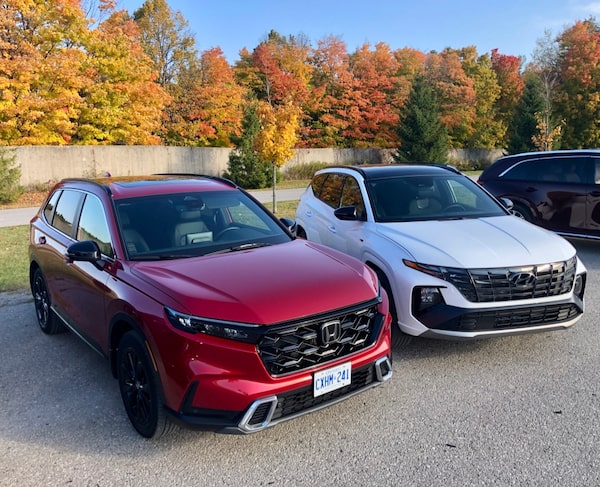
The Hyundai Tucson and Honda CR-V are two of the best-selling hybrids in the country's largest vehicle segment.Jeremy Sinek/The Globe and Mail
Honda has been making hybrid vehicles almost as long as Toyota, yet until recently its electrified portfolio in Canada was sparse, intermittent, and all too often, a little peculiar. Think Honda Insight or CR-Z.
That finally changed last year, when hybrid models were added in the next-generation 2023 redesign of its top-selling nameplate, the CR-V compact crossover.
The CR-V is a player, competing in the country’s largest vehicle segment, but if Honda is serious about moving its hybrid options into the mainstream, it needs more trim levels. Currently, the CR-V’s hybrid powertrain is limited to the loftier trims, optional on the EX-L and standard on the Touring. To put that into perspective, Toyota offers the RAV4 Hybrid in a base LE trim for almost $11,000 less than the hybrid CR-V EX-L’s price of $46,775.
The RAV4 is by far the top seller in its segment, but it’s due for a redo soon (the current generation made its debut in model-year 2019), so its adversary here is another segment stalwart, the Hyundai Tucson. The Tucson doesn’t offer a hybrid/base-trim combo either, but the three trims it does offer are all less expensive than the Honda’s: $40,599 for either the N-Line (as tested) or Luxury trims; and $43,999 for the Ultimate (all prices exclude freight, fees and taxes).
Tech specs
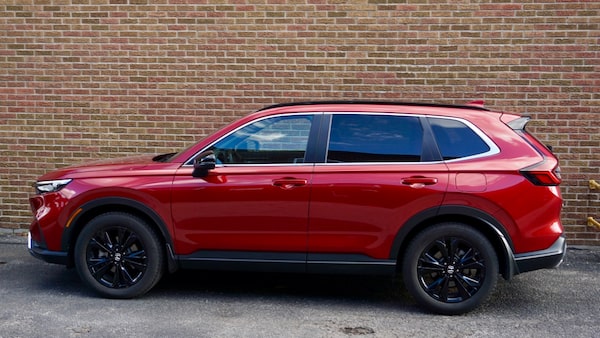
The side view of the Honda CR-V hybrid.Jeremy Sinek/The Globe and Mail
2024 Honda CR-V Touring Hybrid
- Base price/as tested: $49,775/$50,075 (plus $2,000 freight, plus fees and taxes)
- Engine: Two-litre, naturally aspirated four-cylinder/dual-motor hybrid, 204 horsepower and 247 lb-ft of torque
- Transmission/drive: E-CVT/all-wheel drive
- Fuel consumption (litres per 100 kilometres): 6.0 city/6.9 highway
- Alternatives: Hyundai Tucson, Kia Sportage, Toyota RAV4
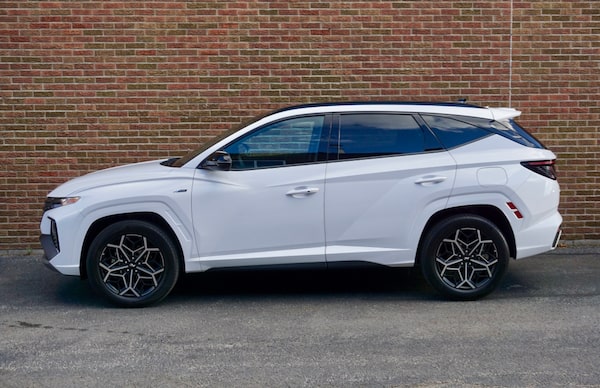
The side view of the Hyundai Tucson.Jeremy Sinek/The Globe and Mail
2024 Hyundai Tucson N-Line Hybrid
- Base price/as tested: $40,599/$40,599 (plus $1,950 freight, plus fees and taxes).
- Engines: 1.6-litre turbocharged four-cylinder/single-motor hybrid, 226 horsepower and 258 lb-ft of torque
- Transmission/drive: Six-speed automatic/all-wheel drive
- Fuel consumption (litres per 100 kilometres): 6.3 city/6.6 highway
- Alternatives: Honda CR-V hybrid, Kia Sportage hybrid, Toyota RAV4 hybrid
Looks
Take your pick between the handsomely chiselled if somewhat rectilinear looks of the Honda, or the Hyundai’s more interesting (contrived?) concoction of curves and creases. Black roof rails and 19-inch rims are the only visual cues that distinguish the CR-V’s Touring trim from the EX-L. In the Tucson lineup, N-Line-exclusive styling cues include distinct grille, bumpers, rear spoiler and 19-inch wheel design.
Interior
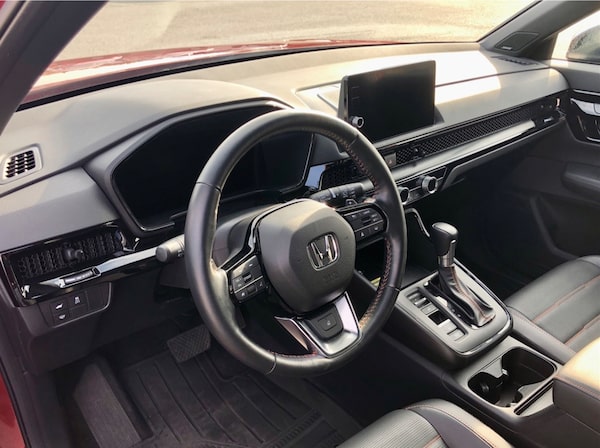
The CR-V’s free-standing screen may not suit all tastes, but the interior is otherwise quite traditional and user-friendly with lots of tactile switches and knobs.Jeremy Sinek/The Globe and Mail
Official passenger volumes rank them both among the roomiest crossovers in their segment. The Tucson’s 108.2 cubic feet (3,064 litres) slightly tops the CR-V’s 106 (3,002), mainly on the strength of rear-seat headroom and hip room, but who’s quibbling when either of these compact SUVs contain sprawl space worthy of a full-size sedan?
The Tucson’s range of seat adjustment better accommodates those who like or need a tall-in-the-saddle posture. On the other hand, the Honda’s sightlines are better. Greater differences emerge in factors that come down to personal taste, both aesthetic and functional. For example, a touchscreen that’s free-standing (Honda) or integrated (Hyundai); a conventional shift lever (Honda) or push-button drive selector (Hyundai); digital gauges that resemble traditional analog versions (Honda) or configurable ones that look more like CGI (Hyundai); old-school twist knobs and push-buttons on the centre stack (Honda) or a touch-sensitive black panel setup (Hyundai).
Bottom line, the Honda’s cabin will appeal more to conservative tastes while the Hyundai is more tech-forward. And add a minor credit to the Honda for its side-by-side cupholders.
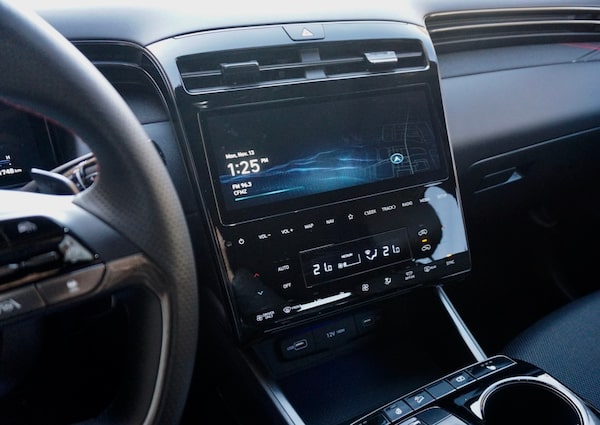
The audio and climate controls are separate from the touch-screen and always accessible but they are still touch-sensitive switches.Jeremy Sinek/The Globe and Mail
Performance
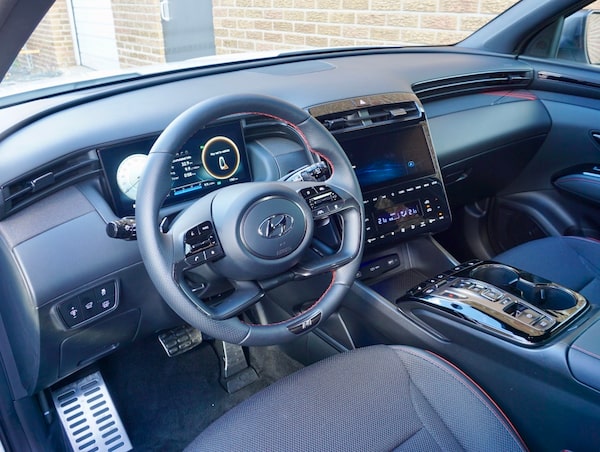
The Tucson’s gauge cluster is obviously a screen, most switches are touch-sensitive and the drive selector is push-button – all very new-age – yet the main touchscreen integrated into the dashboard is a more traditional touch.Jeremy Sinek/The Globe and Mail
We expected to enjoy the Tucson more. It is more powerful (226 horsepower versus 204), torquier (258 lb-ft versus 247), and its transmission is a conventional stepped six-speed versus the CR-V’s electric continuously variable transmission (CVT). However, car magazine zero-to-60 acceleration tests are inconclusive: Car and Driver cites 7.9 seconds for the Honda and 7.1 for the Hyundai, but Motor Trend reversed the rankings with 7.6 and 7.8 seconds, respectively. Call it a wash.
More surprisingly, we preferred the performance feel of the Honda. The Tucson’s 1.6-litre turbo engine is impressively refined, but the Honda’s naturally aspirated two-litre is even silkier. Better still, it cunningly collaborates with the electric motor, a motor/generator and a two-speed gearbox to deliver pretend upshift rev-drops like a many-speed stepped transmission, but with zero shift shock. The unique transmission, which Honda labels e-CVT, banishes the random-revving effect of traditional CVTs.
Likewise, chassis dynamics see the Honda slightly outclass its very good rival. Both steer confidently and ride firmly, but the Honda was more agile through a slalom test, and more balanced at its cornering limits; perhaps more relevant to most drivers, the Honda’s suspension also better damps after-shock jiggle on broken pavement.
Official ratings for fuel consumption make the CR-V more frugal in the city and the Tucson better on the highway, meeting in the middle with the same 6.4-litres-per-100-kilometre combined rating. Real world, we used the Tucson almost entirely for long highway drives and returned 7.5 litres per 100 kilometres; in the CR-V, five days of mixed driving around the Greater Toronto Area returned 7.0.
Technology
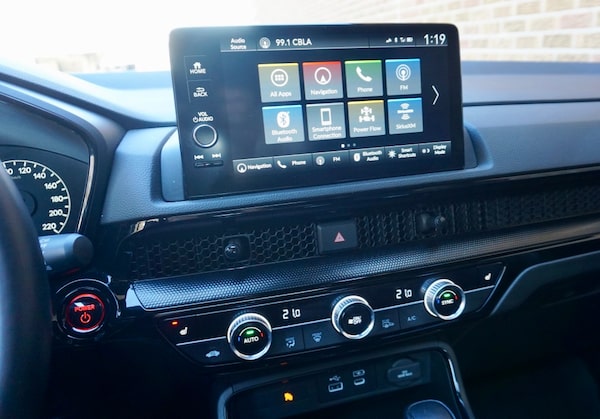
The CR-V’s climate controls.Jeremy Sinek/The Globe and Mail
Both feature numerous safety and driver-assist technologies, including adaptive cruise, automatic braking and lane following. But they vary somewhat with regard to whether they only alert, or also avert. For example, both have rear cross-traffic monitoring, but only the Hyundai’s includes automatic braking; conversely, only the Honda brakes automatically in tight-quarters parking manoeuvres. Amo infotainment assets, most expected modern conveniences are present, though only the Honda has wireless phone charging.
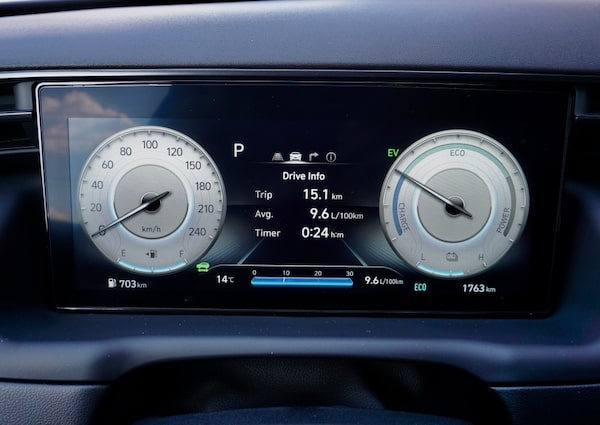
The Tucson’s configurable gauge cluster makes no attempt to disguise its digitality; even the 'traditional' display options look obviously CGI.Jeremy Sinek/The Globe and Mail
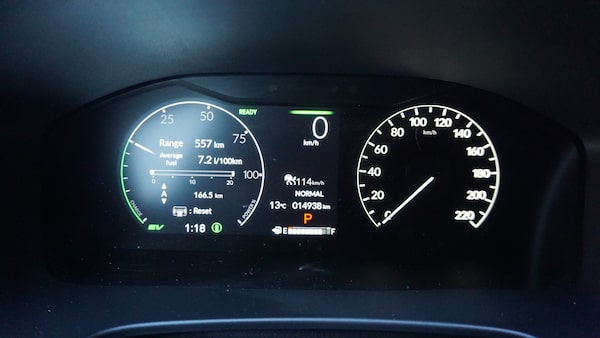
The Honda’s gauge cluster is digital, but it looks like a classic analogue display.Jeremy Sinek/The Globe and Mail
Cargo
In their non-hybrid versions, the CR-V marginally outspaces the Tucson (1,113 litres versus 1,095 seats up, 2,166 versus 2,108 seats down). However, the Tucson has a two-level cargo deck, which can boost its volume above the CR-V’s. And that’s still true on the Tucson Hybrid, whereas space usurped by the CR-V Hybrid’s under-floor battery reduces its volumes to 1,028 and 2,030 litres. In terms of user-friendliness, the Tucson’s seats-folded cargo area is more level (with the deck in its upper position). On the other hand, credit the CR-V for its lower lift-over height.
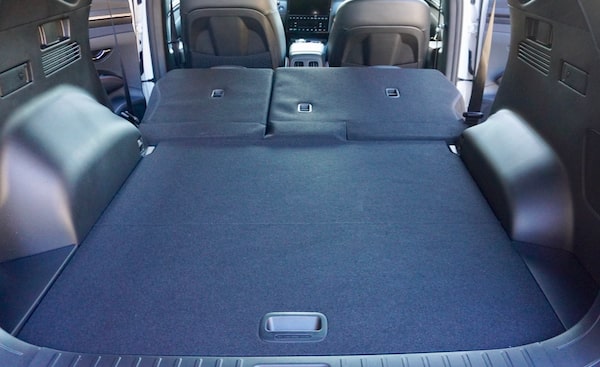
Usefully, the Hyundai’s cargo deck can be set high or low, but even in its higher position it’s not completely flush with the folded seat-backs.Jeremy Sinek/The Globe and Mail
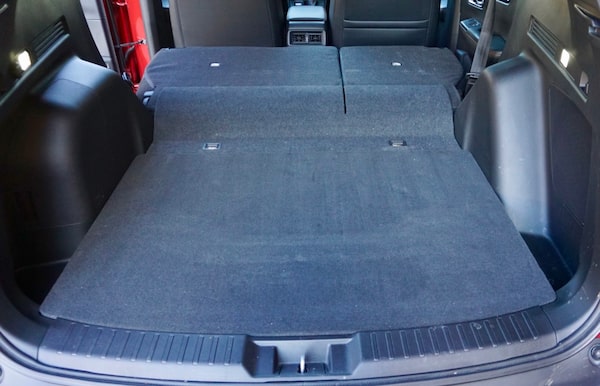
The CR-V’s cargo deck is fixed in one position that leaves a ramp up to the folded seatbacks. We were able to lift the deck, but the unfinished space below contains the battery and should not be used for storage.Jeremy Sinek/The Globe and Mail
The verdict
Whether it’s the Touring trim tested or the EX-L, it’s tough to justify the Honda’s higher price on the basis solely of specifications and features. Indeed, on a purely features-per-dollar basis, you could get a top-trim Tucson plug-in hybrid, with more bells and whistles, for the same price as the CR-V Touring. That said, the Honda does deliver a subtly more premium driving experience, along with more-classic driver interfaces.
Shopping for a new car? Check out the new Globe Drive Build and Price Tool to see the latest discounts, rebates and rates on new cars, trucks and SUVs. Click here to get your price.